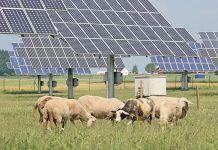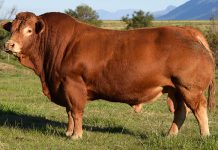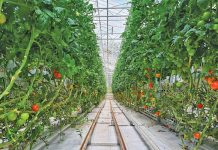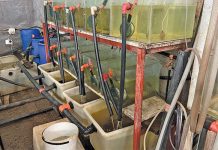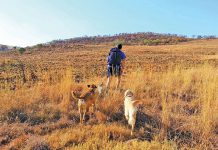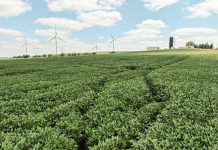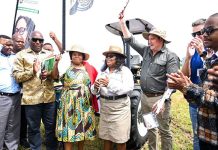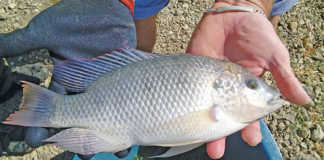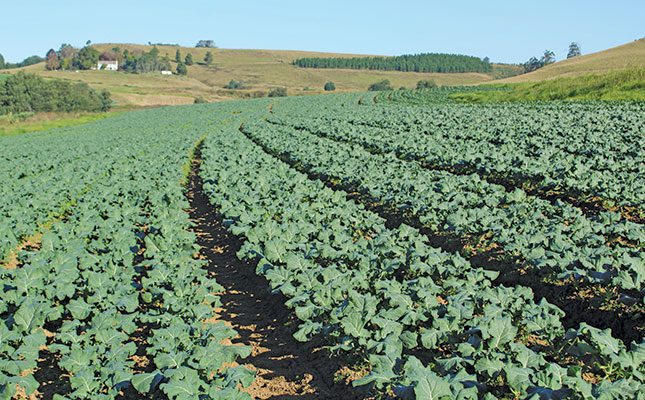
Photo: Lindi Botha
Farmers face numerous challenges that impact the viability of their businesses, many of which – like unpredictable weather and market behaviour – are beyond their control. However, structures can be put in place to make farming enterprises more resilient, help increase production and margins, and reduce their environmental impact.
Andrew Dale, PwC Africa’s agribusiness leader, highlights four approaches and technologies that will help agricultural businesses in this regard.
“Globally, we need to increase food production to meet the growing need for affordable food. Looking at the South African landscape, we’ve seen areas that need improvement if our food production is to remain sustainable.
“These include increasing success rates for family businesses, implementing end-to-end farm management, impact measurement to help agribusinesses tell their environmental, social, and governance [ESG] stories, and collecting data at the farm level to help food companies with traceability,” he says.
-
Formalising family businesses
Family-owned businesses form the backbone of the South African agriculture sector. Unlike other companies that measure success in quarterly terms, family businesses measure success in generations, ensuring the preservation of family values and legacy.
Dale, however, notes that only 60% of family businesses survive into the second generation, and only 32% into the third.
“Successful family businesses strike a balance between professional management and responsible ownership, while maintaining a healthy family dynamic. The relationships between family members – those involved in the business and those who are not – can affect the management of the company in ways that simply do not exist in non-family businesses,” he explains.
Yolandi Kruger, director of and agricultural adviser at Dunamus Agri Advisory in Bloemfontein, Free State, explains that while for most farming businesses the two biggest reasons for failure are related to finances or production (failed harvests or big production losses), for family businesses it is managing conflict. “If conflict can’t be resolved, the business often ends up being sold,” she says.
Kruger emphasises the need for businesses to have a constitution in place that guides how decisions are taken, who has the power to make them, and how conflict will be handled.
“The constitution need not provide every detail, but there should be principles in place that guide, for example, whether grievances will be dealt with via email, in person or through a mediator. Principles over salary increases, promotions and who receives what share of the profit must also be clear,” she adds.
Another major risk for family businesses is the lack of succession planning or planning for changes in management. “If one partner dies and the other needs to buy their share but doesn’t have the money, it jeopardises the future of the business,” she explains.
There are many similar scenarios that are problematic and must be planned for: a divorce that impacts finances or ownership, the earlier-than-expected death of a patriarch, or marriage and a new generation of children that may place expectations on the farm’s income.
Often, the business is not at a scale that can support multiple families or be split between children. Farmers need to know how such situations will be handled before they occur so there is no disruption to the business.
Kruger says estate taxes and transfer fees can cripple a business when the owner passes away and the farm must be passed on to someone else.
“Financial planning for such an eventuality must be done years in advance. This can be done by setting aside a percentage of profits each year, or even a herd of cattle that can be sold when funds are needed.”
Easing the process of transferring ownership requires the correct structures to be in place. This means incorporating the farm into either a company or trust, rather than having all assets in one person’s name, so that they aren’t frozen when the owner dies.
Kruger notes that company documents and testaments must be in agreement over what happens when a farm owner dies. “If the testament states that ownership is transferred to a certain person, then the company documents or trust must state the same.
“It’s also important to understand that a testament or trust is not a succession plan. There must be written documents that state that if person A dies, person B will take over; or if person C gets divorced, then this or that happens. Open communication is key and it’s important to have these conversations with everyone, early enough, to avoid conflict later on,” she explains.
In terms of choosing successors, families need to determine whether only blood relatives will be eligible or not.
“If only family are eligible, a proper analysis of personality types and leadership characteristics must be done to ensure that those chosen to run the business have the necessary skills. This also helps to determine if there are any skills shortages, which should then be addressed,” says Kruger.
Where a family chooses to bring in outsiders to manage the business, roles must be clearly defined, especially when it comes to who makes the final decisions.
Creating a constitution should be an inclusive process that gives all role players sufficient time to consider all eventualities, deal breakers, values, and desired outcomes.
Kruger says the document should serve as a guide for business decisions across generations and should not be easily altered: “Therefore, consensus is crucial, or there will always be conflict.”
2. From dirt to data
While the sophistication of farming systems has increased in recent decades, Dale says it is not uncommon to see South African farmers writing notes about weather and crops on scattered pieces of paper.
“Agriculturalists will have to make real progress in the digital era. As dirt and data intersect, digital tools will provide solutions to some of the biggest challenges that agribusiness faces in the years ahead,” he adds.
This includes, for example, the need for new technologies to efficiently manage scarce water resources. Dale says that like all industries, farming will increasingly require lower overheads and leaner business models.
“Efficiency will be a key goal that digital solutions are poised to deliver, particularly when it comes to ag-tech, precision farming, and the ability to make more informed decisions,” he says.
Drones, multispectral and satellite imagery are already providing valuable information to farmers, such as whether a particular area or crop is unrecoverable and not worth spending more money on. The Internet of Things – the connected network of sensors and Internet-enabled technology – is making light work of mundane yet critical farm maintenance.
“Being able to check the state of fences, machines, levels and health of water tanks, or whether a gate has been shut without manual inspection is just the start. Over time, artificial intelligence [AI] and machine learning will make these operational decisions autonomously,” says Dale.
He believes that agricultural production will increasingly be supported by technology like AI and big data, affording farmers the more focused and precise application of inputs. This, in turn, improves productivity and, if used correctly, will reduce the environmental footprint.
“AI provides farm monitoring and pest-management solutions, helping farmers see above their crops and below the ground where the naked eye cannot. AI can also be used for predictive analysis, like suggesting the time of sowing and scheduling irrigation, reducing the margin for error,” he says.
However, collecting data means little if the data can’t be used to support decision-making. While structuring and analysing data has lagged behind collection technologies, Dale foresees that much progress will be made in the next few years, bringing new and actionable insights.
End-to-end management approaches could include financial management to facilitate budgeting, forecasting and monitoring expenses, revenues and profitability. In terms of logistics optimisation, new technologies will help farmers optimise transportation and reduce post-harvest losses. Monitoring tools that track carbon footprints, water usage and biodiversity will be useful to help farmers meet environmental goals.
3. Reporting on impact
South African agribusinesses face increasing pressure from various stakeholders to assess and manage their impacts on society. They are expected to support an economic system in which value creation and increased growth improve the lives of individuals and the health of societies.
Frans van Wyk, director of Stellenbosch-based advisory firm Agrifusion, says ESG reporting is no longer just a buzz phrase, it’s becoming essential for farmers.
“By showing how sustainable their practices are, farmers can build trust with consumers, meet legal requirements, and keep their products in high-demand markets,” he explains.
Complicating such reporting is the fact that each ESG pillar requires a different set of data to report on. Farmers are a long way off from having a one-stop data shop that can collect all of this information and present it to the market in a way that makes their ESG practices clear.
For environmental reporting, farmers need to include information on water use, carbon footprints, soil health, and biodiversity. Dale explains that stakeholders want to know, for example, how sustainable farming activities are, what power (renewable or otherwise) is being used, if water resources are being managed responsibly, and a myriad other environmental and societal factors.
Van Wyk adds that precision farming technology – with tools like GPS-equipped tractors, soil sensors, and water-flow monitors – can provide accurate environmental data.
Farm-management software like MyFarmWeb or AgriEdge can help centralise data on production and sustainability.
Social reporting includes job creation, the number of families fed, community upliftment, economic value to the region, and fair labour practices.
Certification programmes like GlobalG.A.P, the Sustainability Initiative of South Africa, and Fair Trade can guide farmers on what to measure and how to report.
“Impact assessments have become an indispensable tool for responsible, thriving and resilient agribusiness organisations. Failure to provide robust and credible impact data can erode stakeholder trust and diminish an agricultural organisation’s social licence to operate,” cautions Dale.
4. Traceability in the food chain
Enhanced traceability in food systems is important for a number of reasons. Systems that can better trace the origin and journey of food to market result in faster recalls and crisis management when food is contaminated.
Transparency in the supply chain also provides consumers with better peace of mind about the production and labour practices behind their food.
However, the world is far from having an ideal traceability system in place. Dale says that today’s food supply chains are best described as systems of systems – opaque, dynamic and multilayered systems that lack a verifiable view from farm to fork.
“The challenge for food companies is that while most have traceability systems in place, they are often incomplete and may not be able to trace food all the way back to the farm.
“Most companies can trace one step up or down along their supply chain – they know who they bought food ingredients from, but they may be in the dark about the quality and testing systems in place at those companies, and really unclear on those supplying their suppliers,” explains Dale.
Agriculture, food and beverage companies, and retailers are therefore trying to assure the security, safety and quality of their food.
Van Wyk notes that while South Africa’s food traceability systems have improved over the past few years, there is room for further improvement.
“Certifications like HACCP [Hazard Analysis Critical Control Point] ensure basic traceability in regulated sectors. But there are still gaps, especially in small- to medium-sized farms, since they can’t necessarily afford sophisticated systems,” he says.
Van Wyk suggests that agricultural businesses like Hortgro and Grain SA collaborate to help their members share costs and access systems that might otherwise be too expensive.
Data integration also requires more work.
Van Wyk notes that there is often no unified platform to link data across the supply chain, leading to delays in identifying contamination sources.
For farmers, the scope of data collection is wide, but data that major food companies could require include information on production, harvesting, processing, transportation, storage, and sales.
Traceability practices in South African agriculture use technologies like barcoding, radio-frequency identification tags, and blockchain to track products from the farm to the consumer.
Van Wyk mentions supplier management software platforms, such as FoodLogiQ and AgriChain, as ways to track produce from farm to fork.
“These systems work like a digital diary for your produce, recording every step from planting to the supermarket shelf. This makes it easy to track and fix issues if something goes wrong,” he says.
Being able to track food and know its whole journey from farm to consumer is as much an opportunity as it is a line of defence in good food-safety management, which ultimately bolsters a farmer’s sustainability.
Email Andrew Dale at [email protected], Yolandi Kruger at [email protected], and Frans van Wyk at [email protected].

